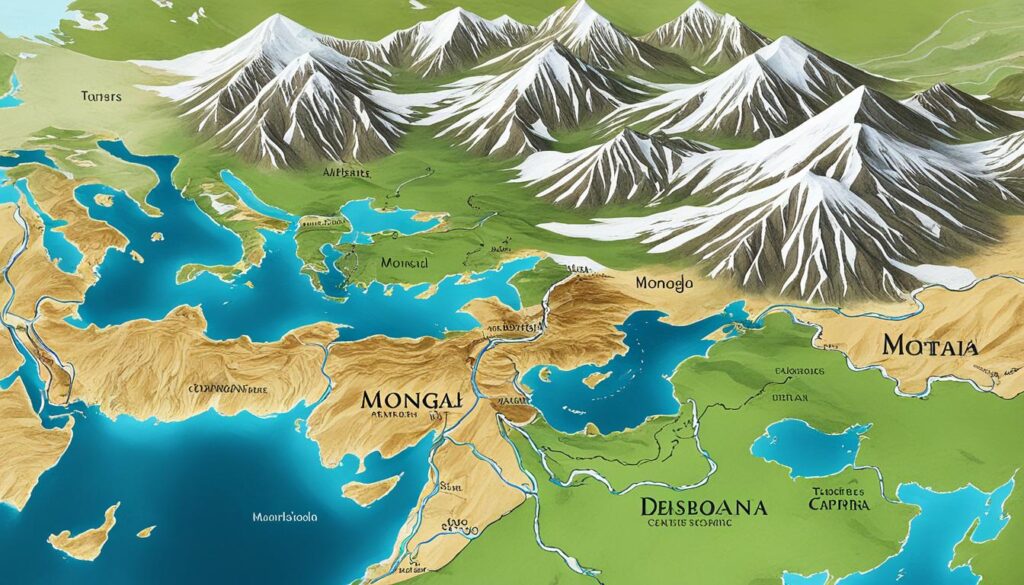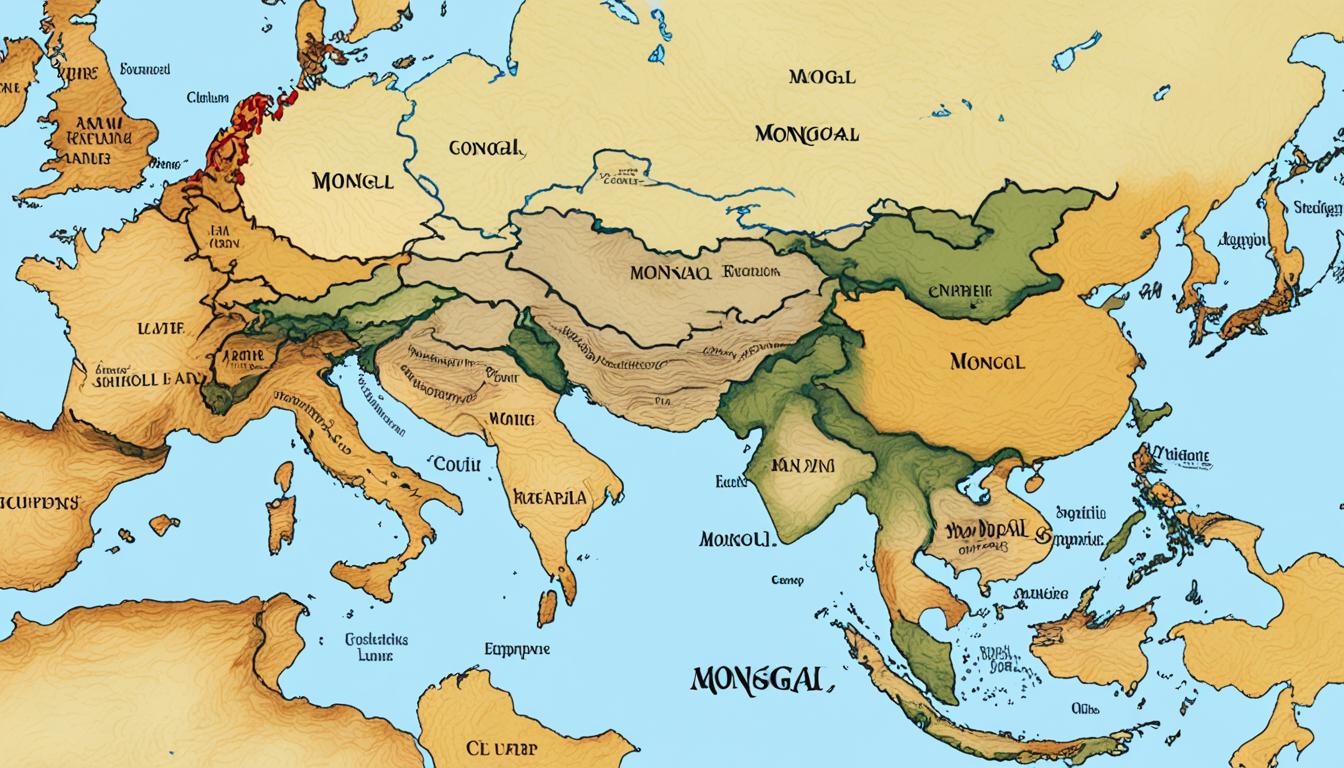The Mongol Empire, founded by Genghis Khan in 1206, was the largest contiguous land empire in world history. Spanning from the Pacific Ocean to the Danube River and the Persian Gulf at its peak, this vast empire covered an astonishing 9 million square miles (23 million square km) of territory. The rise of the Mongol Empire began with the unification of nomadic tribes in the Mongol heartland under the visionary leadership of Temüjin, who would later be known as Genghis Khan.
Genghis Khan’s military prowess and strategic brilliance enabled the rapid expansion of the Mongol Empire, as he and his descendants conquered lands from China to Eastern Europe. The Mongols’ innovative military tactics, characterized by their skilled horsemanship and powerful composite bows, proved decisive in their victories over larger armies. The empire’s efficient governance, facilitated by the Yam relay system and the codification of laws, further contributed to its stability and longevity.
Key Takeaways
- The Mongol Empire was the largest contiguous land empire in world history, covering 9 million square miles at its peak.
- Genghis Khan founded the empire in 1206 by unifying nomadic tribes in the Mongol heartland.
- The Mongols’ military prowess and innovative tactics enabled their rapid expansion across Eurasia.
- Efficient governance, including the Yam relay system and codified laws, contributed to the empire’s stability.
- The Mongol Empire’s legacy continues to shape the geopolitical landscape of Eurasia centuries after its decline.
Origin and Expansion of the Mongol Empire
The Mongol Empire, which would become history’s largest contiguous land empire, originated from the steppes of present-day Mongolia in East Asia. It was there that the charismatic leader Genghis Khan began uniting the disparate Mongol tribes under his rule in the early 13th century. With a formidable army of skilled horsemen and archers, Genghis Khan launched a series of successful military campaigns that rapidly expanded the empire’s territory.
The Mongols first set their sights on the Tangut kingdom of Hsi Hsia (Xi Xia) in 1205, waging war until its conquest in 1209. Emboldened by this victory, Genghis Khan turned his attention to the Jin dynasty in north China, which fell to the Mongols by 1215. The relentless conquests continued as the Mongols absorbed the Khara-Khitai state in east Turkistan in 1218 and then proceeded to invade the Khwārezmian Empire in Persia, a campaign that lasted from 1219 to 1225.
The scope of the Mongol conquests was not limited to Asia; advance troops even raided cities in Crimea in 1223, foreshadowing the empire’s expansion into Europe. After Genghis Khan’s death in 1227, his successors continued to expand the empire’s boundaries. At its height, the Mongol Empire spanned a vast swath of Eurasia, stretching from Korea to Hungary and from Russia to the Persian Gulf and Southeast Asia.
The Mongols’ military prowess, characterized by their cavalry’s mobility and the strategic brilliance of their leaders, was a key factor in their successful campaigns. The integration of conquered peoples into the Mongol army further strengthened their forces as they pushed the boundaries of their empire ever outward. Through these relentless conquests, the Mongol Empire under Genghis Khan and his successors reshaped the political and cultural landscape of Eurasia, leaving an indelible mark on world history.
Mongol Empire’s Land Size
The Mongol Empire, at its peak, was the largest contiguous land empire in history, covering an astounding 24 million square kilometers (9.27 million square miles). This vast territory encompassed approximately 17.81% of the Earth’s total land surface, making it one of the most expansive empires ever known. The sheer size of the Mongol Empire’s land area is a testament to the military prowess and strategic brilliance of its leaders, particularly Genghis Khan and his successors.
To put the Mongol Empire’s land size into perspective, it is essential to compare it with other notable empires throughout history. While the British Empire eventually surpassed the Mongol Empire in total land area, the Mongol Empire remains the largest contiguous empire ever recorded. Other significant empires, such as the Russian Empire, which covered 22.8 million square kilometers at its height, and the Qing dynasty, which spanned 14.7 million square kilometers, pale in comparison to the Mongol Empire’s territorial extent.

The Mongol Empire’s expansive territory allowed for unprecedented levels of trade, cultural exchange, and technology transfer across Eurasia. The Silk Road, which had been a vital trade route for centuries, flourished under Mongol rule, connecting the East and West like never before. This facilitated the exchange of goods, ideas, and innovations, ultimately shaping the course of world history.
The enormity of the Mongol Empire’s land size is a clear indication of the Mongols’ exceptional ability to conquer and govern vast territories. Through a combination of military might, strategic alliances, and effective administration, the Mongols were able to maintain control over their extensive empire for more than a century. This remarkable achievement showcases the Mongol Empire’s place among the greatest empires in human history, with its land area serving as a powerful symbol of its dominance and influence.
Factors Contributing to the Mongol Empire’s Vast Expansion
The Mongol Empire’s rapid expansion and conquest of vast territories can be attributed to several key factors, primarily their exceptional military tactics and army organization. Under the leadership of Genghis Khan, the Mongol army was divided into decimal subsections, with soldiers grouped into units of 10, 100, 1,000, and 10,000. This highly structured organization allowed for effective communication, discipline, and coordination on the battlefield.
The Mongol army was predominantly composed of highly mobile cavalry units, renowned for their speed, maneuverability, and archery skills. These mounted warriors were able to cover great distances quickly, often surprising their enemies with swift attacks. The Mongols’ nomadic lifestyle and adaptability to harsh conditions also played a crucial role in their military success, as they could traverse challenging environments and sustain themselves in remote regions.
Innovative battlefield tactics and strategies were hallmarks of the Mongol military. They employed feigned retreats to lure enemies into traps, used flanking maneuvers to surround and overwhelm their opponents, and engaged in psychological warfare to demoralize their adversaries. The Mongols were also skilled in siege warfare, often employing captured engineers to construct advanced siege engines and utilizing their cavalry’s mobility to cut off supply lines and isolate besieged cities.
The combination of these factors – their military tactics, army organization, nomadic lifestyle, and adaptability – allowed the Mongols to conquer and control a vast empire that stretched from the Pacific Ocean to the edges of Central Europe. Their ability to quickly assimilate new technologies and strategies from conquered peoples further enhanced their military prowess and facilitated their rapid expansion across the Eurasian continent.
Fragmentation and Decline of the Mongol Empire
Despite its vast size and power, the Mongol Empire began to unravel due to succession disputes among the descendants of Genghis Khan. Following the death of Möngke Khan in 1259, the empire fractured into rival khanates led by different grandsons of the great conqueror. The Toluid Civil War (1260–1264) between Kublai Khan and Ariq Böke further divided the once-unified empire.
By 1294, the Mongol Empire had fragmented into four separate khanates: the Golden Horde in the northwest, the Chagatai Khanate in Central Asia, the Ilkhanate in Persia, and the Yuan dynasty in China. While these khanates continued to rule their respective regions with varying degrees of success, they never again unified into a single empire. The decline of the Mongol Empire was a gradual process, with the Ilkhanate disintegrating first (1335–1353), followed by the fall of the Yuan dynasty in 1368.
The fragmentation and decline of the Mongol Empire continued over the following centuries. The Golden Horde began to break apart in the 15th century, while the Chagatai Khanate eventually dissolved in 1687. The once-mighty empire that had reshaped the world under Genghis Khan and his successors was now a collection of smaller, independent states. The Mongol succession crisis and the resulting division of the empire into competing khanates ultimately led to its dissolution and the end of the Mongol era.

Leave a Reply